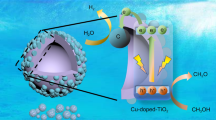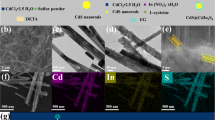Abstract
Using photocatalytic hydrogen evolution (PHE) technology is a powerful way to solve the energy shortage. In this study, a hexagonal hollow tubular nitrogen-doped carbon (N−C)-coated In2O3/CdZnS heterojunction photocatalyst was in situ synthesized using a simple oil bath heating method. Results show that the PHE rate of N−C/In2O3/CdZnS (∼22.87 µmol h−1) is ∼2.4 times that of pristine CdZnS (∼9.49 µmol h−1) and ∼54.5 times that of pristine In2O3 (∼0.42 µmol h−1). After four cycles, the PHE rate can still retain more than 90% of the original. Its excellent photocatalytic performance is mainly attributed to the following aspects: (1) the N−C layer acts as an electron transport bridge, which ensures the efficient electron transfer of the photocatalytic reaction; (2) the hollow tubular structure enhances the light reflection and absorption; (3) the N−C/In2O3/CdZnS heterostructure improves the carrier recombination and photocorrosion; (4) the large specific surface area and mesoporous structure provide a large number of reactive sites. This study provides a novel idea for designing visible-light-type heterojunction catalysts.

摘要
光催化析氢(PHE)技术是解决当前能源短缺问题的有力途径之一. 本文采用简单的油浴加热方法原位合成了六方空心管状氮掺杂碳包覆的In2O3/CdZnS异质结光催化剂. 结果表明, N−C/In2O3/CdZnS(∼22.87 µmol h−1)的光催化析氢速率是原始CdZnS (∼9.49 µmol h−1)的∼2.4倍, 是原始In2O3(∼0.42µmol h−1)的∼54.5倍. 经过4个循环后, 光催化析氢量仍能达到原来的90%以上. 其优异的光催化性能主要归功于以下几个方面: (1) 氮掺杂碳层作为电子传输桥梁, 保证了光催化反应的高效电子转移; (2) 中空管状结构增强了光的反射, 增强了光吸收性能;(3) 形成N−C/In2O3/CdZnS异质结构, 改善了载流子复合和光腐蚀问题;(4) 大的比表面积和介孔结构提供了大量的反应位点. 因此, 本研究为设计可见光型异质结催化剂提供了新思路.
Similar content being viewed by others
References
Wang Q, Domen K. Particulate photocatalysts for light-driven water splitting: Mechanisms, challenges, and design strategies. Chem Rev, 2020, 120: 919–985
Qi MY, Conte M, Anpo M, et al. Cooperative coupling of oxidative organic synthesis and hydrogen production over semiconductor-based photocatalysts. Chem Rev, 2021, 121: 13051–13085
Feng L, Pang J, She P, et al. Metal-organic frameworks based on group 3 and 4 metals. Adv Mater, 2020, 32: 2004414
Xia B, Zhang Y, Shi B, et al. Photocatalysts for hydrogen evolution coupled with production of value-added chemicals. Small Methods, 2020, 4: 2000063
Zuo Q, Liu T, Chen C, et al. Ultrathin metal-organic framework nanosheets with ultrahigh loading of single Pt atoms for efficient visible-light-driven photocatalytic H2 evolution. Angew Chem Int Ed, 2019, 58: 10198–10203
Hou J, Cao S, Sun Y, et al. Atomically thin mesoporous In2O3-x/In2S3 lateral heterostructures enabling robust broadband-light photo-electrochemical water splitting. Adv Energy Mater, 2018, 8: 1701114
Tan M, Ma Y, Yu C, et al. Boosting photocatalytic hydrogen production via interfacial engineering on 2D ultrathin Z-scheme ZnIn2S4/g-C3N4 heterojunction. Adv Funct Mater, 2022, 32: 2111740
Khan K, Tao X, Shi M, et al. Visible-light-driven photocatalytic hydrogen production on Cd0.5Zn0.5S nanorods with an apparent quantum efficiency exceeding 80%. Adv Funct Mater, 2020, 30: 2003731
Zhang W, Zhou X, Huang J, et al. Noble metal-free core-shell CdS/iron phthalocyanine Z-scheme photocatalyst for enhancing photocatalytic hydrogen evolution. J Mater Sci Tech, 2022, 115: 199–207
Zhang W, Zhao S, Xing Y, et al. Sandwich-like P-doped h-BN/ZnIn2S4 nanocomposite with direct Z-scheme heterojunction for efficient photocatalytic H2 and H2O2 evolution. Chem Eng J, 2022, 442: 136151
Li W, Wang X, Ma Q, et al. CdS@h-BN heterointerface construction on reduced graphene oxide nanosheets for hydrogen production. Appl Catal B-Environ, 2021, 284: 119688
Zhan X, Zheng Y, Li B, et al. Rationally designed Ta3N5/ZnIn2S4 1D/2D heterojunctions for boosting visible-light-driven hydrogen evolution. Chem Eng J, 2022, 431: 134053
Hou H, Shao G, Yang W. Recent advances in g-C3N4-based photocatalysts incorporated by MXenes and their derivatives. J Mater Chem A, 2021, 9: 13722–13745
Wang Q, Astruc D. State of the art and prospects in metal-organic framework (MOF)-based and MOF-derived nanocatalysis. Chem Rev, 2020, 120: 1438–1511
Nguyen HL. Metal-organic frameworks can photocatalytically split water—Why not?. Adv Mater, 2022, 34: 2200465
Liu J, Feng J, Lu L, et al. A metal-organic-framework-derived (Zn0.95−Cu0.05)0.6Cd0.4S solid solution as efficient photocatalyst for hydrogen evolution reaction. ACS Appl Mater Interfaces, 2020, 12: 10261–10267
Song Y, Li Z, Zhu Y, et al. Titanium hydroxide secondary building units in metal-organic frameworks catalyze hydrogen evolution under visible light. J Am Chem Soc, 2019, 141: 12219–12223
Yang H, Tang J, Luo Y, et al. MOFs-derived fusiform In2O3 mesoporous nanorods anchored with ultrafine CdZnS nanoparticles for boosting visible-light photocatalytic hydrogen evolution. Small, 2021, 17: 2102307
Shen Q, Zhou S, Yang FL, et al. Engineering one-dimensional hollow beta-In2S3/In2O3 hexagonal micro-tubes for efficient broadband-light photocatalytic performance. J Mater Chem A, 2022, 10: 4974–4980
Han L, Jing F, Zhang J, et al. Environment friendly and remarkably efficient photocatalytic hydrogen evolution based on metal organic framework derived hexagonal/cubic In2O3 phase-junction. Appl Catal B-Environ, 2021, 282: 119602
Li R, Sun L, Zhan W, et al. Engineering an effective noble-metal-free photocatalyst for hydrogen evolution: Hollow hexagonal porous microrods assembled from In2O3@carbon core-shell nanoparticles. J Mater Chem A, 2018, 6: 15747–15754
Zhou X, Luo J, Jin B, et al. Sustainable synthesis of low-cost nitrogen-doped-carbon coated Co3W3C@g-C3N4 composite photocatalyst for efficient hydrogen evolution. Chem Eng J, 2021, 426: 131208
Wang A, Chen Y, Zheng Z, et al. In situ N-doped carbon-coated mulberry-like cobalt manganese oxide boosting for visible light driving photocatalytic degradation of pharmaceutical pollutants. Chem Eng J, 2021, 411: 128497
Yang W, Ma G, Fu Y, et al. Rationally designed Ti3C2 MXene@TiO2/CuInS2 Schottky/S-scheme integrated heterojunction for enhanced photocatalytic hydrogen evolution. Chem Eng J, 2022, 429: 132381
Zhan X, Fang Z, Li B, et al. Rationally designed Ta3N5@ReS2 heterojunctions for promoted photocatalytic hydrogen production. J Mater Chem A, 2021, 9: 27084–27094
Lin S, Li S, Huang H, et al. Synergetic piezo-photocatalytic hydrogen evolution on CdxZn1−xS solid-solution 1D nanorods. Small, 2022, 18: 2106420
Lin S, Zhang Y, You Y, et al. Bifunctional hydrogen production and storage on 0D–1D heterojunction of Cd0.5Zn0.5S@halloysites. Adv Funct Mater, 2019, 29: 1903825
Kai S, Xi B, Wang Y, et al. One-pot synthesis of size-controllable core-shell CdS and derived CdS@ZnxCd1−xS structures for photocatalytic hydrogen production. Chem Eur J, 2017, 23: 16653–16659
Zhong T, Yu Z, Jiang R, et al. Surface-activated Ti3C2Tx MXene cocatalyst assembled with CdZnS-formed 0D/2D CdZnS/Ti3C2−A40 Schottky heterojunction for enhanced photocatalytic hydrogen evolution. Sol RRL, 2022, 6: 2100863
Ha E, Ruan S, Li D, et al. Surface disorder engineering in ZnCdS for cocatalyst free visible light driven hydrogen production. Nano Res, 2022, 15: 996–1002
Huang HB, Fang ZB, Yu K, et al. Visible-light-driven photocatalytic H2 evolution over CdZnS nanocrystal solid solutions: Interplay of twin structures, sulfur vacancies and sacrificial agents. J Mater Chem A, 2020, 8: 3882–3891
Chen J, Lv S, Shen Z, et al. Novel ZnCdS quantum dots engineering for enhanced visible-light-driven hydrogen evolution. ACS Sustain Chem Eng, 2019, 7: 13805–13814
Liang R, Shen L, Jing F, et al. NH2-mediated indium metal-organic framework as a novel visible-light-driven photocatalyst for reduction of the aqueous Cr(VI). Appl Catal B-Environ, 2015, 162: 245–251
Hou Q, Li X, Pi Y, et al. Construction of In2S3@NH2−MIL−68(In)@In2S3 sandwich homologous heterojunction for efficient CO2 photoreduction. Ind Eng Chem Res, 2020, 59: 20711–20718
Zhang Q, Gu H, Wang X, et al. Robust hollow tubular ZnIn2S4 modified with embedded metal-organic-framework-layers: Extraordinarily high photocatalytic hydrogen evolution activity under simulated and real sunlight irradiation. Appl Catal B-Environ, 2021, 298: 120632
Zhang X, Zhang S, Tang Y, et al. Recent advances and challenges of metal-organic framework/graphene-based composites. Compos Part B-Eng, 2022, 230: 109532
Pan T, Shen Y, Wu P, et al. Thermal shrinkage behavior of metal-organic frameworks. Adv Funct Mater, 2020, 30: 2001389
Li F, Liu Y, Mao B, et al. Carbon-dots-mediated highly efficient hole transfer in I–III–VI quantum dots for photocatalytic hydrogen production. Appl Catal B-Environ, 2021, 292: 120154
Wang Y, Liu X, Liu J, et al. Carbon quantum dot implanted graphite carbon nitride nanotubes: Excellent charge separation and enhanced photocatalytic hydrogen evolution. Angew Chem Int Ed, 2018, 57: 5765–5771
Wang S, Guan BY, Lou XWD. Construction of ZnIn2S4−In2O3 hierarchical tubular heterostructures for efficient CO2 photoreduction. J Am Chem Soc, 2018, 140: 5037–5040
Sun L, Zhuang Y, Yuan Y, et al. Nitrogen-doped carbon-coated CuO−In2O3 p−n heterojunction for remarkable photocatalytic hydrogen evolution. Adv Energy Mater, 2019, 9: 1902839
Zhang Q, Zhang J, Wang X, et al. In-N-In sites boosting interfacial charge transfer in carbon-coated hollow tubular In2O3/ZnIn2S4 heterostructure derived from In-MOF for enhanced photocatalytic hydrogen evolution. ACS Catal, 2021, 11: 6276–6289
Sun L, Li R, Zhan W, et al. Rationally designed double-shell dodecahedral microreactors with efficient photoelectron transfer: N-doped-C-encapsulated ultrafine In2O3 nanoparticles. Chem Eur J, 2019, 25: 3053–3060
Fang LJ, Li YH, Liu PF, et al. Facile fabrication of large-aspect-ratio g-C3N4 nanosheets for enhanced photocatalytic hydrogen evolution. ACS Sustain Chem Eng, 2017, 5: 2039–2043
Zhao S, Li K, Wu J, et al. Metal-organic framework-derived tubular In2O3−C/CdIn2S4 heterojunction for efficient solar-driven CO2 conversion. ACS Appl Mater Interfaces, 2021, 14: 20375–20384
Huang L, Li B, Su B, et al. Fabrication of hierarchical Co3O4@CdIn2S4 p−n heterojunction photocatalysts for improved CO2 reduction with visible light. J Mater Chem A, 2020, 8: 7177–7183
Wang Q, Chen Y, Liu X, et al. Sulfur doped In2O3−CeO2 hollow hexagonal prisms with carbon coating for efficient photocatalytic CO2 reduction. Chem Eng J, 2021, 421: 129968
Cao R, Yang H, Zhang S, et al. Engineering of Z-scheme 2D/3D architectures with Ni(OH)2 on 3D porous g-C3N4 for efficiently photocatalytic H2 evolution. Appl Catal B-Environ, 2019, 258: 117997
Ouyang C, Quan X, Zhang C, et al. Direct Z-scheme ZnIn2S4@MoO3 heterojunction for efficient photodegradation of tetracycline hydrochloride under visible light irradiation. Chem Eng J, 2021, 424: 130510
Yang YY, Zhang XG, Niu CG, et al. Dual-channel charges transfer strategy with synergistic effect of Z-scheme heterojunction and LSPR effect for enhanced quasi-full-spectrum photocatalytic bacterial inactivation: New insight into interfacial charge transfer and molecular oxygen activation. Appl Catal B-Environ, 2020, 264: 118465
Acknowledgements
This work was supported by the Independent Cultivation Program of Innovation Team of Jinan City (2019GXRC011), the Natural Science Foundation of Shandong Province (ZR2021ME143), and the National Natural Science Foundation of China (51908242).
Author information
Authors and Affiliations
Contributions
Author contributions Zhang W conducted the experiment and wrote the paper; Zhao S carried out theoretical calculations; Qin H, Zheng Q and Zhang P analyzed the data; Li X and Li C drew the graphs; Wang T and Li N validated the experiment; Xu X provided financial support and useful suggestions; Zhang S put forward useful suggestions.
Corresponding authors
Ethics declarations
Conflict of interest The authors declare that they have no conflict of interest.
Additional information
Supplementary information Supporting data are available in the online version of the paper.
Weijie Zhang received a bachelor degree from the School of Physical Science and Technology at the University of Jinan in 2020. He is now pursing his master degree under the supervision of Prof. Xijin Xu at the School of Physics and Technology, University of Jinan, China. His main research interest is the synthesis and characterization of two-dimensional nanomaterials for photocatalytic applications.
Shouwei Zhang received his PhD from Hefei University of Technology in 2015. His main interest is the preparation of photocatalytic materials.
Xijin Xu received his PhD degree from the Institute of Solid State Physics, Chinese Academy of Sciences in 2007. He conducted his postdoctoral research at Nanyang Technological University, Singapore in 2007 and then joined the National Institute for Materials Science, Japan (2008–2010) and Griffith University in Australia (2010–2011). Currently, he is a full professor at the University of Jinan. His most recent research interests include the synthesis and characterization of functional micro/nanostructures and their applications in environmental remediation and energy storage.
Electronic supplementary material
40843_2022_2209_MOESM1_ESM.pdf
Metal-organic framework-derived nitrogen-doped carbon-coated hollow tubular In2O3/CdZnS heterojunction for efficient photocatalytic hydrogen evolution
Rights and permissions
About this article
Cite this article
Zhang, W., Zhao, S., Qin, H. et al. Metal-organic framework-derived nitrogen-doped carbon-coated hollow tubular In2O3/CdZnS heterojunction for efficient photocatalytic hydrogen evolution. Sci. China Mater. 66, 1042–1052 (2023). https://doi.org/10.1007/s40843-022-2209-9
Received:
Accepted:
Published:
Issue Date:
DOI: https://doi.org/10.1007/s40843-022-2209-9




